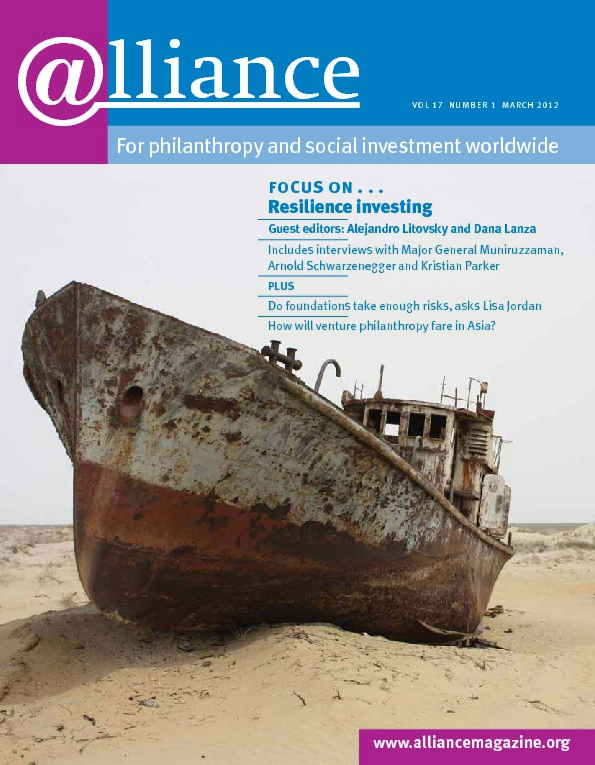We instinctively donate for the relief of disasters, but while relief reduces suffering and helps recovery, it seldom reduces the risks faced by vulnerable communities. In fact, a growing emphasis on relief diverts attention from preventing future disasters, which perpetuates the vulnerability of communities at risk. Donors need also to start investing in reducing risk, and disaster insurance is one way to do it.
The majority of low-income communities at risk in India are not protected from the loss of life, livelihood and assets that results from their vulnerability to natural disasters. India’s National Policy on Disaster Management, drawn up in 2009, concedes that the government cannot compensate all the victims of a disaster at a sufficient scale and speaks of promoting new financial tools such as ‘catastrophe risk financing, risk insurance, catastrophe bonds, micro-finance and insurance’ to cover such losses. However, this policy is not matched with investment from private or public sources.
There is a great potential opportunity for the Indian market to absorb innovative and affordable micro-insurance products, something humanitarian donors can capitalize on. Disaster losses in India can be financed through the rapidly growing Indian economy, a well-established insurance industry and successful global experiences of risk financing through insurance. What is needed is a leap ahead by one or more donors to build on successful cases to increase the reach and incidence of this practice.
While most of the money raised through emergency appeals in south Asia (as elsewhere) goes to relief and reconstruction, a few local organizations have successfully demonstrated the value of promoting disaster micro-insurance. One such organization is the All India Disaster Mitigation Institute (AIDMI). A consultation with communities in Bhuj following the 2001 Gujarat earthquake revealed that only 2 per cent of those surveyed had insurance of any type. From this, a disaster micro-insurance scheme emerged, designed by AIDMI with initial support from two regulated public sector insurance companies and called AfatVimo, which means ‘disaster insurance’ in Gujarati.
AfatVimo covers five risks: (limited) losses of life, trade stock, livelihood assets, house and house contents of policyholders, with an annual premium of around $4.50 and a total potential benefit of $1,560 (not necessarily the maximum payout) across the various components of the coverage. The scheme covers damage or loss through 19 kinds of disaster including earthquake, flood, fire, cyclone, lightning strike and landslides.
The product was first sold in April 2004 to 3,700 policyholders from the at least 900,000 families who lost shelter after the 2001 Gujarat earthquake, and was later extended to another 3,500 people from among the 2004 tsunami victims in Tamil Nadu, the 2005 Jammu and Kashmir earthquake victims, and 2007-8 flood victims in Bihar. As part of the relief and recovery activities, the communities were informed of the possible ways to pool risk, and transfer it through insurance. AfatVimo is a financial tool for risk sharing, reducing the policyholder’s underlying risks and offering financial protection. In addition to the policy itself, policyholders are supported with micro-mitigation measures such as fire safety, seismic-safe construction practices and business development support.
AIDMI is now looking to extend the policy to other disaster-affected communities in India. In fact, interest in AfatVimo and the way it could be implemented in their regions has grown up in six Indian states and 11 Asian countries, including Fiji, Indonesia, the Maldives, Nepal and the Solomon Islands.
This innovation addresses the problem of the perpetual risk to which poor communities are subject, not least by the unknowing humanitarian relief sector. Successful pilots and a proven financial model provide a strong case for protecting people’s lives and assets through insurance. The opportunity to scale up this model to new locations is substantial and individual donors and philanthropic institutions can drive innovation where bureaucratic authorities or project-focused agencies are slower to respond to opportunity.
Mihir Bhatt is managing trustee at the All India Disaster Mitigation Institute. Email mihir@aidmi.org
For more information
http://www.aidmi.org/risk-transfer-initiative.asp
bestteam@aidmi.org





Comments (0)